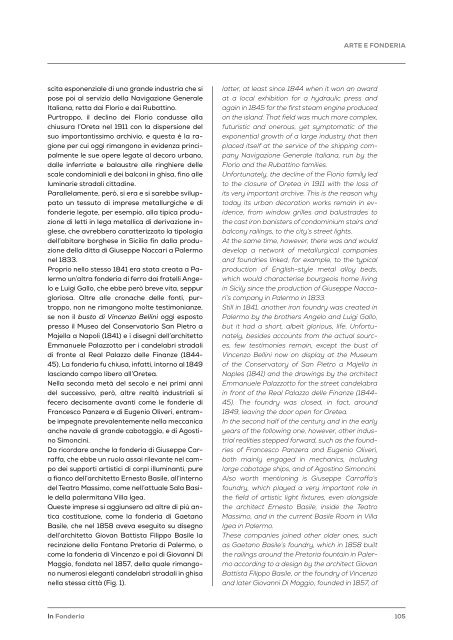In Fonderia 6 2023
Sesto numero del 2023 di In Fonderia
Sesto numero del 2023 di In Fonderia
You also want an ePaper? Increase the reach of your titles
YUMPU automatically turns print PDFs into web optimized ePapers that Google loves.
ARTE E FONDERIA<br />
scita esponenziale di una grande industria che si<br />
pose poi al servizio della Navigazione Generale<br />
Italiana, retta dai Florio e dai Rubattino.<br />
Purtroppo, il declino dei Florio condusse alla<br />
chiusura l’Oreta nel 1911 con la dispersione del<br />
suo importantissimo archivio, e questa è la ragione<br />
per cui oggi rimangono in evidenza principalmente<br />
le sue opere legate al decoro urbano,<br />
dalle inferriate e balaustre alle ringhiere delle<br />
scale condominiali e dei balconi in ghisa, fino alle<br />
luminarie stradali cittadine.<br />
Parallelamente, però, si era e si sarebbe sviluppato<br />
un tessuto di imprese metallurgiche e di<br />
fonderie legate, per esempio, alla tipica produzione<br />
di letti in lega metallica di derivazione inglese,<br />
che avrebbero caratterizzato la tipologia<br />
dell’abitare borghese in Sicilia fin dalla produzione<br />
della ditta di Giuseppe Naccari a Palermo<br />
nel 1833.<br />
Proprio nello stesso 1841 era stata creata a Palermo<br />
un’altra fonderia di ferro dai fratelli Angelo<br />
e Luigi Gallo, che ebbe però breve vita, seppur<br />
gloriosa. Oltre alle cronache delle fonti, purtroppo,<br />
non ne rimangono molte testimonianze,<br />
se non il busto di Vincenzo Bellini oggi esposto<br />
presso il Museo del Conservatorio San Pietro a<br />
Majella a Napoli (1841) e i disegni dell’architetto<br />
Emmanuele Palazzotto per i candelabri stradali<br />
di fronte al Real Palazzo delle Finanze (1844-<br />
45). La fonderia fu chiusa, infatti, intorno al 1849<br />
lasciando campo libero all’Oretea.<br />
Nella seconda metà del secolo e nei primi anni<br />
del successivo, però, altre realtà industriali si<br />
fecero decisamente avanti come le fonderie di<br />
Francesco Panzera e di Eugenio Oliveri, entrambe<br />
impegnate prevalentemente nella meccanica<br />
anche navale di grande cabotaggio, e di Agostino<br />
Simoncini.<br />
Da ricordare anche la fonderia di Giuseppe Carraffa,<br />
che ebbe un ruolo assai rilevante nel campo<br />
dei supporti artistici di corpi illuminanti, pure<br />
a fianco dell’architetto Ernesto Basile, all’interno<br />
del Teatro Massimo, come nell’attuale Sala Basile<br />
della palermitana Villa Igea.<br />
Queste imprese si aggiunsero ad altre di più antica<br />
costituzione, come la fonderia di Gaetano<br />
Basile, che nel 1858 aveva eseguito su disegno<br />
dell’architetto Giovan Battista Filippo Basile la<br />
recinzione della Fontana Pretoria di Palermo, o<br />
come la fonderia di Vincenzo e poi di Giovanni Di<br />
Maggio, fondata nel 1857, della quale rimangono<br />
numerosi eleganti candelabri stradali in ghisa<br />
nella stessa città (Fig. 1).<br />
latter, at least since 1844 when it won an award<br />
at a local exhibition for a hydraulic press and<br />
again in 1845 for the first steam engine produced<br />
on the island. That field was much more complex,<br />
futuristic and onerous, yet symptomatic of the<br />
exponential growth of a large industry that then<br />
placed itself at the service of the shipping company<br />
Navigazione Generale Italiana, run by the<br />
Florio and the Rubattino families.<br />
Unfortunately, the decline of the Florio family led<br />
to the closure of Oretea in 1911 with the loss of<br />
its very important archive. This is the reason why<br />
today its urban decoration works remain in evidence,<br />
from window grilles and balustrades to<br />
the cast iron banisters of condominium stairs and<br />
balcony railings, to the city’s street lights.<br />
At the same time, however, there was and would<br />
develop a network of metallurgical companies<br />
and foundries linked, for example, to the typical<br />
production of English-style metal alloy beds,<br />
which would characterise bourgeois home living<br />
in Sicily since the production of Giuseppe Naccari’s<br />
company in Palermo in 1833.<br />
Still in 1841, another iron foundry was created in<br />
Palermo by the brothers Angelo and Luigi Gallo,<br />
but it had a short, albeit glorious, life. Unfortunately,<br />
besides accounts from the actual sources,<br />
few testimonies remain, except the bust of<br />
Vincenzo Bellini now on display at the Museum<br />
of the Conservatory of San Pietro a Majella in<br />
Naples (1841) and the drawings by the architect<br />
Emmanuele Palazzotto for the street candelabra<br />
in front of the Real Palazzo delle Finanze (1844-<br />
45). The foundry was closed, in fact, around<br />
1849, leaving the door open for Oretea.<br />
<strong>In</strong> the second half of the century and in the early<br />
years of the following one, however, other industrial<br />
realities stepped forward, such as the foundries<br />
of Francesco Panzera and Eugenio Oliveri,<br />
both mainly engaged in mechanics, including<br />
large cabotage ships, and of Agostino Simoncini.<br />
Also worth mentioning is Giuseppe Carraffa’s<br />
foundry, which played a very important role in<br />
the field of artistic light fixtures, even alongside<br />
the architect Ernesto Basile, inside the Teatro<br />
Massimo, and in the current Basile Room in Villa<br />
Igea in Palermo.<br />
These companies joined other older ones, such<br />
as Gaetano Basile’s foundry, which in 1858 built<br />
the railings around the Pretoria fountain in Palermo<br />
according to a design by the architect Giovan<br />
Battista Filippo Basile, or the foundry of Vincenzo<br />
and later Giovanni Di Maggio, founded in 1857, of<br />
<strong>In</strong> <strong>Fonderia</strong><br />
105














